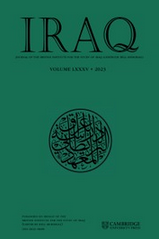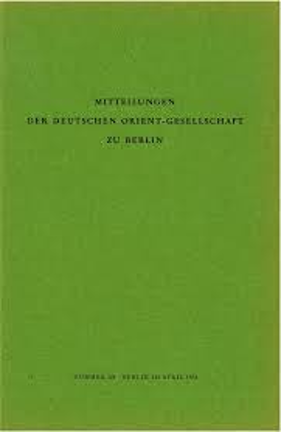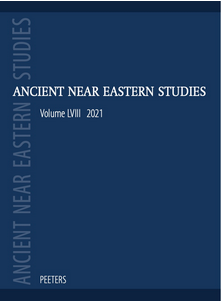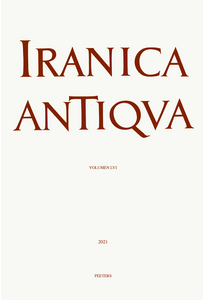Publications so far
0
| 1. |  | Amelirad, Sheler; Razmpoush, Abbas; Khanmohamadi, Behroz: Kani Charmou, an Iron Age II graveyard. In: Iraq, vol. 85, pp. 49-71, 2024. (Type: Journal Article | Abstract | Links | BibTeX)@article{nokey,Examining the archaeological findings within the Mannaean kingdom, a significant association with Assyria emerges, highlighting these regions’ interconnectedness. The influence of both Urartian and Assyrian cultures on the Mannaean people becomes evident, indicating a shared cultural heritage or intimate exchanges among these cultures. Notably, the Kani Charmou graveyard in Mannaea serves as a compelling example, revealing a rich assortment of artifacts that parallel those discovered in Ziwiye, a renowned archaeological site in the region. These diverse grave goods unequivocally demonstrate the existence of a robust trade and exchange network between Mannaea and its neighbouring western counterpart, Assyria, and the profound impact of Assyrian culture on Mannaean society. This connection is also evident in religious practices, which show similarities. Through stylistic analysis and the identification of parallels in metal vessels, glazed jars, and a cylinder seal, the proposed dating of the Kani Charmou graveyard aligns with the Iron Age II period. |
| 2. |  | Brown, Michael: The Mountain Fortresses of Rabana-Merquly in Iraqi-Kurdistan. In: BAF-Online: Proceedings of the Berner Altorientalisches Forum, vol. 4, no. 1, 2020. (Type: Journal Article | Abstract | Links | BibTeX)@article{nokey,The twin fortresses of Rabana-Merquly are situated on the western side of Mt. Piramagrun, one of the most prominent massifs in the Zagros Mountains. A defining feature of these adjoining settlements are their matching, approximately life-size rock-reliefs depicting a ruler in Parthian dress, which flank the entrance to both sites. Behind the perimeter walls several structures have been recorded including a citadel and a sanctuary complex. The combined intramural area is in excess of 40 hectares. Based on the style of relief sculptures, and the material culture of their associated intramural settlements, occupation is dated to the early first millennium A.D. Investigations at Rabana-Merquly are a collaboration between Heidelberg University and the Sulaymaniyah Directorate of Antiquities. This talk gives an overview of the main fieldwork results to date, emphasizing the relationship between the fortified settlements and the wider landscape of the central Zagros highlands. |
| 3. |  | Brown, Michael; Rasheed, Kamal; Dörr, Roxana; Heiler, Jan: Die Bergbefestigung von Rabana-Merquly in Irakisch-Kurdistan: Ein Vorbericht der Grabungskampagne 2019. In: Mitteilungen der Deutschen Orient-Gesellschaft, iss. 152, pp. 91-110, 2020. (Type: Journal Article | Abstract | Links | BibTeX)@article{nokey,On the slopes of Mt. Piramagrun in the Zagros Mountains of Iraqi Kurdistan lies the fortified site of Rabana-Merquly. Ruins spread across c. 100 ha represent a major occupation during the Parthian period. Matching rock-reliefs that depict an anonymous ruler flank the two main entrances to the settlements. Pronounced similarities in attire between these sculptures and the statue of a king of Adiabene found at Hatra suggest a possible identification for both the individual depicted in relief (Natounissar) and the ancient city (Natounia-on-the-Kapros). Fieldwork in 2019 continued our ongoing programme of survey and excavation, with more detailed investigation of the complex at the entrance to Rabana valley. |
| 4. |  | Amelirad, Sheler; Azizi, Eghbal: Kani Koter, Iron Age Cemetery from Iranian Kurdistan. In: Iran, vol. 59, iss. 1, pp. 57-76, 2019. (Type: Journal Article | Abstract | Links | BibTeX)@article{nokey,Kani Koter cemetery is located in Iranian Kurdistan, close to Dere Pemeyan (or Persian Dare Panbedan) village, between the ancient sites of Ziwiye and Karafto Cave (Figure 1). In this article, we discuss the material discovered from one of the graves in this cemetery, its chronology, and cultural associations. Unfortunately, tomb robbers plundered this grave, completely ruining the tomb's stratigraphic context. Fortunately, in 2016 the Cultural Heritage Organization of Kurdistan rescued all of the stolen artefacts, and today the collection is stored at the Sanandaj Museum. The grave has yielded a number of elaborately decorated objects that belong nominally to Assyrian, Urartian and Mannaean artistic traditions, with the date for the finds being established by means of comparisons with Assyrian and Urartian artefacts. |
| 5. |  | Amelirad, Sheler; Mohajerynezhad, Abdolrezer; Javidkhah, Masoume: A Report on the Excavation at the Mala Mcha Graveyard, Kurdistan, Iran. In: Iran, vol. 55, iss. 2, pp. 171-207, 2017. (Type: Journal Article | Abstract | Links | BibTeX)@article{nokey,The Mala Mcha graveyard is located in Iranian Kurdistan, near the ancient Mannaean site of Ziwiya. Abdolreza Mohajerynezhad and Rasol Oshtodan conducted rescue excavations at Mala Mcha in 2012, and 16 graves were uncovered. Although most of the graves had been plundered by tomb robbers the tomb structures, and especially the grave-goods that remained, suggest an Iron Age III date and close relations with neighbouring sites such as Ziwiye, Qalaichi and Changbar. Most of the graves were covered with large flat slabs and contained one, two or three burials, the exception being tomb no. 7 with 14 burials. |
| 6. |  | Amelirad, Sheler; Razmpoush, Abbas: A Newly Discovered Iron Age Site at Sarrez, Iranian Kurdistan. In: Ancient Near Eastern Studies, vol. 52, pp. 207-216, 2015. (Type: Journal Article | Abstract | Links | BibTeX)@article{nokey,Sarrez is an ancient site in Kurdistan Province, Iran, near the present-day country town of Kamyaran. This site was discovered accidentally during dam construction activities. It has yielded some metal artefacts, potsherds and bones that are comparable to Iron Age III instances. The collection in its entirety is discussed in this article. One of the main objects from Sarrez is a decorated beaker with a scene on its wall that is comparable in many ways to examples of Neo-Assyrian art. The purpose of this paper is to publish and date the metal objects of the Sarrez collection based on this bronze beaker, which is one the few beakers from western Iran which has been found in a secure context. |
| 7. |  | Amelirad, Sheler; Overlaet, Bruno; Haerinck, Ernie: The Iron Age “Zagros Graveyard” Near Sanandaj (Iranian Kurdistan): Preliminary Report on the First Season. In: Iranica Antiqua, vol. 47, pp. 41-99, 2012. (Type: Journal Article | Abstract | Links | BibTeX)@article{nokey,An Iron Age graveyard, for the most part dating from the 8th - 7th century BC, was accidentally discovered in 2008 during road works near Sanandaj, Iranian Kurdistan. Rescue excavations were conducted by the Cultural Heritage Department in Sanandaj. The present contribution reports on these first excavations during which more than 20 graves were discovered in two squares and a trench. A selection of the graves and the burial goods are discussed. |
2024 |
|
 | Amelirad, Sheler; Razmpoush, Abbas; Khanmohamadi, Behroz: Kani Charmou, an Iron Age II graveyard. In: Iraq, vol. 85, pp. 49-71, 2024. (Type: Journal Article | Abstract | Links | BibTeX | Tags: Iron, Iron Age, Kurdistan, Zagros, Zagros Highlands)@article{nokey,Examining the archaeological findings within the Mannaean kingdom, a significant association with Assyria emerges, highlighting these regions’ interconnectedness. The influence of both Urartian and Assyrian cultures on the Mannaean people becomes evident, indicating a shared cultural heritage or intimate exchanges among these cultures. Notably, the Kani Charmou graveyard in Mannaea serves as a compelling example, revealing a rich assortment of artifacts that parallel those discovered in Ziwiye, a renowned archaeological site in the region. These diverse grave goods unequivocally demonstrate the existence of a robust trade and exchange network between Mannaea and its neighbouring western counterpart, Assyria, and the profound impact of Assyrian culture on Mannaean society. This connection is also evident in religious practices, which show similarities. Through stylistic analysis and the identification of parallels in metal vessels, glazed jars, and a cylinder seal, the proposed dating of the Kani Charmou graveyard aligns with the Iron Age II period. |
2020 |
|
 | Brown, Michael: The Mountain Fortresses of Rabana-Merquly in Iraqi-Kurdistan. In: BAF-Online: Proceedings of the Berner Altorientalisches Forum, vol. 4, no. 1, 2020. (Type: Journal Article | Abstract | Links | BibTeX | Tags: Fortification, Kurdistan, Landscape, Parthian, Persian empire, Resilience)@article{nokey,The twin fortresses of Rabana-Merquly are situated on the western side of Mt. Piramagrun, one of the most prominent massifs in the Zagros Mountains. A defining feature of these adjoining settlements are their matching, approximately life-size rock-reliefs depicting a ruler in Parthian dress, which flank the entrance to both sites. Behind the perimeter walls several structures have been recorded including a citadel and a sanctuary complex. The combined intramural area is in excess of 40 hectares. Based on the style of relief sculptures, and the material culture of their associated intramural settlements, occupation is dated to the early first millennium A.D. Investigations at Rabana-Merquly are a collaboration between Heidelberg University and the Sulaymaniyah Directorate of Antiquities. This talk gives an overview of the main fieldwork results to date, emphasizing the relationship between the fortified settlements and the wider landscape of the central Zagros highlands. |
 | Brown, Michael; Rasheed, Kamal; Dörr, Roxana; Heiler, Jan: Die Bergbefestigung von Rabana-Merquly in Irakisch-Kurdistan: Ein Vorbericht der Grabungskampagne 2019. In: Mitteilungen der Deutschen Orient-Gesellschaft, iss. 152, pp. 91-110, 2020. (Type: Journal Article | Abstract | Links | BibTeX | Tags: Fortification, Kurdistan, Landscape, Parthian, Resilience)@article{nokey,On the slopes of Mt. Piramagrun in the Zagros Mountains of Iraqi Kurdistan lies the fortified site of Rabana-Merquly. Ruins spread across c. 100 ha represent a major occupation during the Parthian period. Matching rock-reliefs that depict an anonymous ruler flank the two main entrances to the settlements. Pronounced similarities in attire between these sculptures and the statue of a king of Adiabene found at Hatra suggest a possible identification for both the individual depicted in relief (Natounissar) and the ancient city (Natounia-on-the-Kapros). Fieldwork in 2019 continued our ongoing programme of survey and excavation, with more detailed investigation of the complex at the entrance to Rabana valley. |
2019 |
|
 | Amelirad, Sheler; Azizi, Eghbal: Kani Koter, Iron Age Cemetery from Iranian Kurdistan. In: Iran, vol. 59, iss. 1, pp. 57-76, 2019. (Type: Journal Article | Abstract | Links | BibTeX | Tags: Chronology, Iron Age, Kurdistan, Material Analysis)@article{nokey,Kani Koter cemetery is located in Iranian Kurdistan, close to Dere Pemeyan (or Persian Dare Panbedan) village, between the ancient sites of Ziwiye and Karafto Cave (Figure 1). In this article, we discuss the material discovered from one of the graves in this cemetery, its chronology, and cultural associations. Unfortunately, tomb robbers plundered this grave, completely ruining the tomb's stratigraphic context. Fortunately, in 2016 the Cultural Heritage Organization of Kurdistan rescued all of the stolen artefacts, and today the collection is stored at the Sanandaj Museum. The grave has yielded a number of elaborately decorated objects that belong nominally to Assyrian, Urartian and Mannaean artistic traditions, with the date for the finds being established by means of comparisons with Assyrian and Urartian artefacts. |
2017 |
|
 | Amelirad, Sheler; Mohajerynezhad, Abdolrezer; Javidkhah, Masoume: A Report on the Excavation at the Mala Mcha Graveyard, Kurdistan, Iran. In: Iran, vol. 55, iss. 2, pp. 171-207, 2017. (Type: Journal Article | Abstract | Links | BibTeX | Tags: Chronology, Excavation, Iron, Iron Age, Kurdistan, Zagros Highlands)@article{nokey,The Mala Mcha graveyard is located in Iranian Kurdistan, near the ancient Mannaean site of Ziwiya. Abdolreza Mohajerynezhad and Rasol Oshtodan conducted rescue excavations at Mala Mcha in 2012, and 16 graves were uncovered. Although most of the graves had been plundered by tomb robbers the tomb structures, and especially the grave-goods that remained, suggest an Iron Age III date and close relations with neighbouring sites such as Ziwiye, Qalaichi and Changbar. Most of the graves were covered with large flat slabs and contained one, two or three burials, the exception being tomb no. 7 with 14 burials. |
2015 |
|
 | Amelirad, Sheler; Razmpoush, Abbas: A Newly Discovered Iron Age Site at Sarrez, Iranian Kurdistan. In: Ancient Near Eastern Studies, vol. 52, pp. 207-216, 2015. (Type: Journal Article | Abstract | Links | BibTeX | Tags: Iron Age, Kurdistan, Material Analysis, Zagros, Zagros Highlands)@article{nokey,Sarrez is an ancient site in Kurdistan Province, Iran, near the present-day country town of Kamyaran. This site was discovered accidentally during dam construction activities. It has yielded some metal artefacts, potsherds and bones that are comparable to Iron Age III instances. The collection in its entirety is discussed in this article. One of the main objects from Sarrez is a decorated beaker with a scene on its wall that is comparable in many ways to examples of Neo-Assyrian art. The purpose of this paper is to publish and date the metal objects of the Sarrez collection based on this bronze beaker, which is one the few beakers from western Iran which has been found in a secure context. |
2012 |
|
 | Amelirad, Sheler; Overlaet, Bruno; Haerinck, Ernie: The Iron Age “Zagros Graveyard” Near Sanandaj (Iranian Kurdistan): Preliminary Report on the First Season. In: Iranica Antiqua, vol. 47, pp. 41-99, 2012. (Type: Journal Article | Abstract | Links | BibTeX | Tags: Ceramics, Chronology, Excavation, Iron, Iron Age, Kurdistan, Pottery, Zagros, Zagros Highlands)@article{nokey,An Iron Age graveyard, for the most part dating from the 8th - 7th century BC, was accidentally discovered in 2008 during road works near Sanandaj, Iranian Kurdistan. Rescue excavations were conducted by the Cultural Heritage Department in Sanandaj. The present contribution reports on these first excavations during which more than 20 graves were discovered in two squares and a trench. A selection of the graves and the burial goods are discussed. |
